Well, I managed to time my last COVID update so that it was published the day South Africa announced it had discovered the heavily mutated omicron variant. Does omicron change anything from that update? A little bit, sure. However, those end-of-the-world omicron outlooks you see online and in the media are unwarranted and just aren’t going to happen. As a mathematical modeler and programmer, I am trained to recognize patterns. And the omicron variant is following the exact same pattern that every previous variant of COVID has.
- A country announces they have discovered a new variant
- Experts speculate that this is the variant that will evade vaccines
- Everyone freaks out and panics for a few weeks
- Data proves that vaccines still provide adequate protection against the variant
- You see a wave of the variant sweep through many countries
- Life goes on
With the omicron variant of COVID, most countries are currently in the early stages of step 5. However, there are still two big unknowns: how big will the wave be, and how quickly will it surge?
The Omicron Surge Will Resemble the COVID Spike in India From the Delta Variant
Remember how highly contagious the Delta Variant is? As you can probably guess, the Omicron Variant must be significantly more contagious in order to out-compete Delta. And initial data shows that it is. As a result, Omicron will spread much faster, making the spike taller. But there’s a silver lining: it will come and go quickly. Think of it coming through like a tornado instead of a hurricane. Recall the COVID spike in India from the Delta Variant.
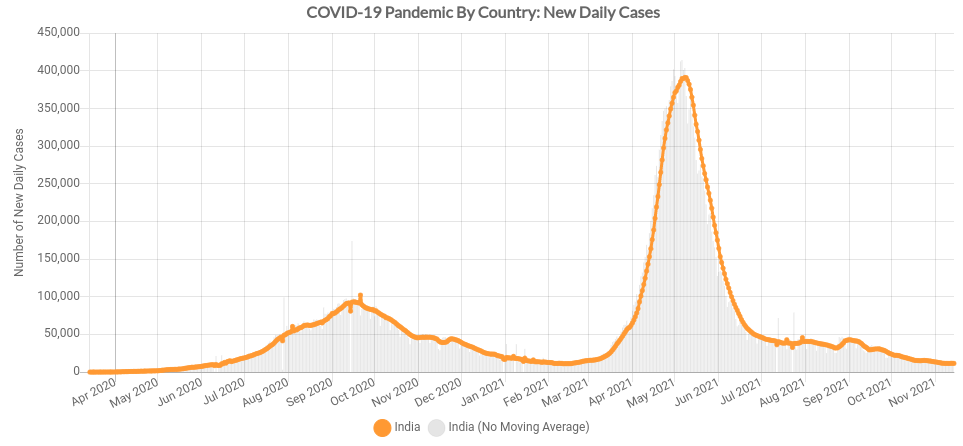
Because Omicron is more contagious than Delta, that spike will be taller, but last shorter. And don’t forget to account for population. With nearly 1.4 billion people, India is the second most populous country in the world. Smaller populations in just about every other country will result in both a shorter and less severe spike. In an Omicron wave, the United States is the only country that has the potential to come anywhere remotely close to the 400,000 daily cases that India saw in their Delta spike. And I think even that is highly unlikely.
COVID Cases from the Omicron Variant Have Already Peaked in Some Countries
Yes, you read that right. The Omicron wave has already peaked in some countries. After South Africa first identified Omicron in late November, health officials quickly contact traced cases back to both Germany and the Netherlands. And guess what? New Omicron cases are now falling in all three countries.
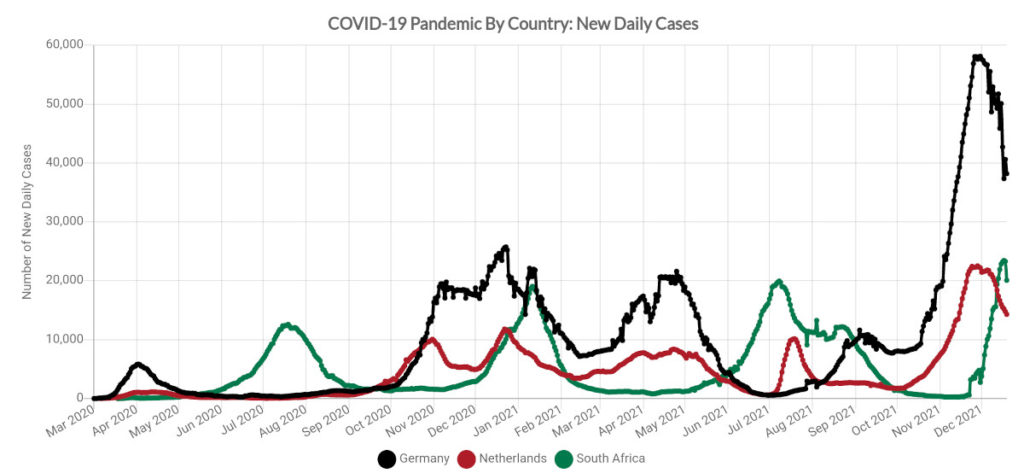
Omicron has obviously spread far beyond those three countries. However, I expect any Omicron surges in other countries will resemble the time series above.
A Word of Caution About South Africa’s Demographics
South Africa has one of the most advanced and sophisticated health science programs in the world. There is nothing wrong with data coming out of South Africa. In fact, I trust their data 100%. The issue lies primarily in South Africa’s age demographics, which heavily skew towards younger people. Just 5.5% of South Africans are over 65. That’s a stark contrast to 17% in the United States, 16% in Canada, and 21% in the European Union. That’s why health officials originally cautioned about reports of omicron in South Africa being primarily mild. Thankfully, data from the European Union seems to confirm that omicron is less severe than Delta.
Additionally, don’t forget that South Africa’s location in the Southern Hemisphere means that they are heading into summer right now. Omicron is so contagious that summer vs winter may not make any significant difference anymore. However, data since the start of the pandemic has repeatedly shown that surges are worse in the winter season, regardless of which hemisphere you live in.
I Believe the Omicron Variant Originated in Europe, Not Africa
Just because South Africa discovered the Omicron variant doesn’t necessarily mean that it originated there. And after looking at the data, I believe that Omicron actually originated in Europe and was then brought to South Africa, not the other way around.
First, let’s recall the new daily COVID cases from Germany, the Netherlands, and South Africa we just looked at in the previous section.

What jumps out at me right away? The slope of the upward side of the omicron spike in late 2021 is identical in all three countries. While it’s not definitive proof, it’s likely that the same variant caused all three surges. And we know for certain that Omicron caused the surge in South Africa. In addition, Notice how the spike starts earlier in both Germany (black) and the Netherlands (red) earlier than it does in South Africa (green). We’ll circle back to this in a sec.
Second, look at how Omicron spread in South Africa. The first clusters emerged in Gauteng Province, which is mostly comprised of the City of Johannesburg. And do you know what’s in Johannesburg? South Africa’s largest international airport. Nearly all international flights in and out of the country go through Johannesburg. As Omicron spread throughout the country, the worst of the outbreak remained in Gauteng. Interestingly, Gauteng was also the first province in South Africa to reach the peak of the Omicron outbreak.
Botswana Contact Traces Omicron Back to Europe…Before Any Evidence of it Appeared in Africa
After popping up in South Africa, Omicron quickly jumped the border into neighboring Botswana. With the help of the South African Health Ministry, the Federal Government of Botswana contact traced omicron cases back to the Netherlands as early as 8 November. And it may have been in Germany earlier than that.

Furthermore, after extensive contact tracing, neither Botswana nor South Africa could find any evidence of the omicron variant in Africa prior to 15 November. If it was in Europe as early as 8 November, but didn’t appear in Africa until the 15th, how could it have originated in Africa? For reference, South Africa announced the discovery of Omicron on 26 November.
Timing of the Omicron Wave Lines Up Perfectly with it Originating in Europe
To prevent confusion, let’s have a look at new daily Covid cases in just Germany. The start of Germany’s Omicron spike lines up perfectly with Botswana’s contact tracing of Omicron back to the Netherlands on 8 November. Germany’s uneven uptick in cases in late October is likely from the Delta Variant.

Repeat the process for the Netherlands and you get the same perfectly-aligned timing.

Interestingly, the data out of both South Africa and Botswana seem to confirm the contact tracing that Omicron was not present in Africa prior to 15 November. Unlike Germany and the Netherlands, South Africa’s Omicron spike did not start until after they announced they had discovered Omicron on 26 November.
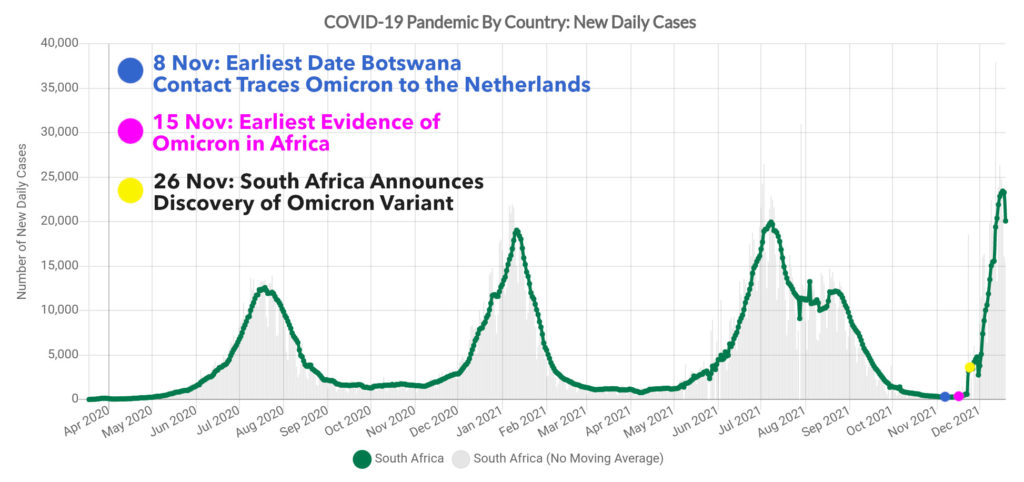
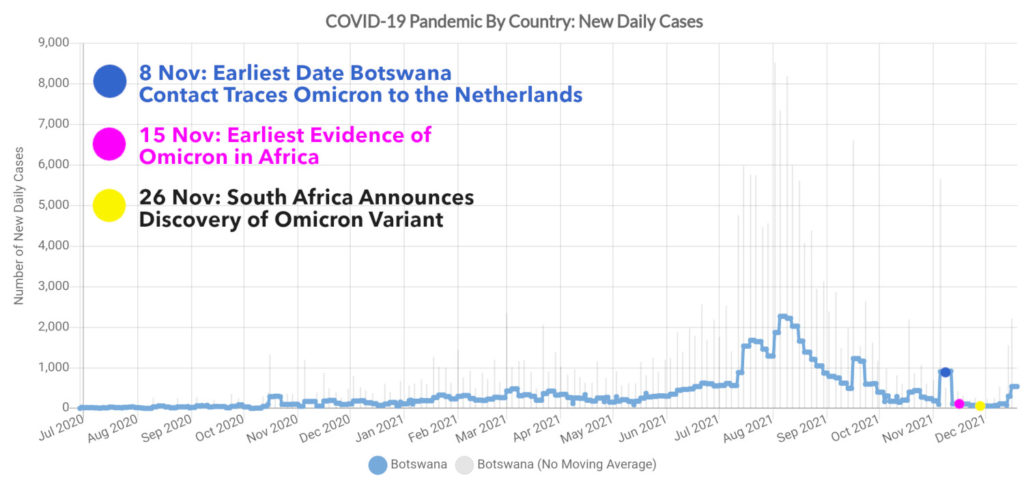
So is this definitive proof that Omicron originated in Europe? Most certainly not. However, it does illustrate how ineffective travel bans are in stopping COVID-19. If my theory is true, banning travel from southern Africa would have done absolutely nothing to stop the Omicron variant if it originated and had already taken hold in Europe.
What Will the Omicron Spike Look Like in the United States, Canada, and Great Britain?
All three countries will see something similar to what India saw with Delta, or what Germany, the Netherlands, and South Africa saw with Omicron. The million dollar question is how big will the spike get, and how long will it last?
To answer those questions, let’s look where each country stands right now. All three countries have started spiking from Omicron. The United States currently has the highest new daily case loads, and as a result, will likely get hit the hardest. The UK is experiencing the biggest spike, while Canada is in the best shape of the three.
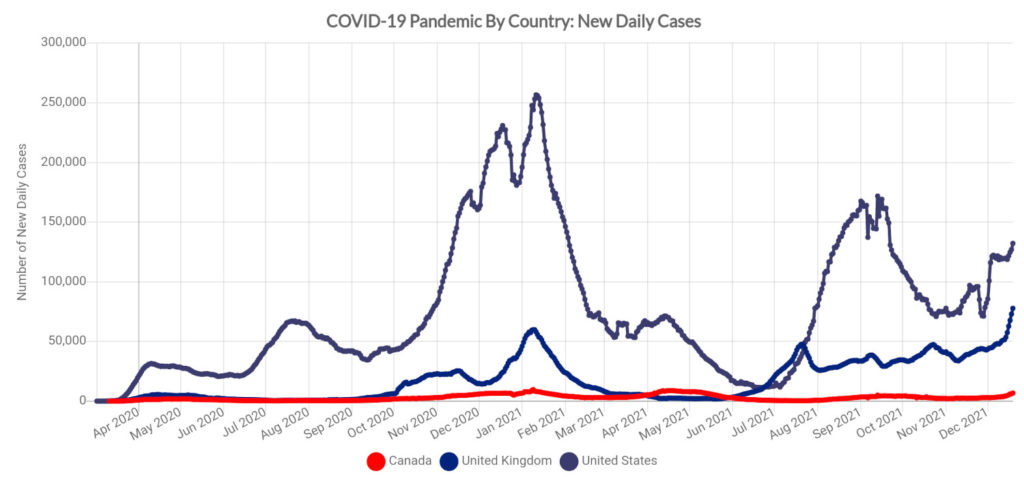
For what to expect, let’s turn to the University of Washington’s Institute of Health Metrics and and Evaluation (IHME) model.
| Parameter | United States | Canada | United Kingdom |
|---|---|---|---|
| Actual New Cases – 20 Dec, 2021 | 132,003 | 6,822 | 77,781 |
| Universal Masks – Max Daily Cases | 196,695 | 10,216 | 63,415 |
| Universal Masks – Peak Date | 16 November, 2021 | 14 Feburary, 2022 | 16 November, 2021 |
| Most Likely – Max Daily Cases | 210,350 | 30,562 | 119,405 |
| Most Likely – Peak Date | 11 January, 2022 | 14 February, 2022 | 6 January, 2022 |
| Worst Case – Max Daily Cases | 771,187 | 195,123 | 280,920 |
| Worst Case – Peak Date | 7 January, 2022 | 6 January, 2022 | 5 January, 2022 |
As expected, I tend to agree with the IHME’s most likely projections. I think both the Universal Masks case as well as the worst-case scenario are both highly unlikely. Holiday gatherings may slightly increase the peak daily cases as well as push the peak date shortly into the future.
We Are Much Better Prepared for Omicron than Any Previous Variant of COVID
Despite all of the doom and gloom predictions, the world is much better prepared for Omicron than any previous variant. First, and foremost, we still have highly effective vaccines. Yes, their effectiveness took a hit, but go back to the Fall of 2020. As companies raced to develop vaccines, most infectious disease experts said that vaccine effectiveness of 50-60% would be a major victory. After a booster shot, both Pfizer and Moderna are reporting 70-75% effectiveness against Omicron.
Furthermore, many more people have immunity after the Delta wave. Through both vaccinations and natural immunity, the pool of susceptible people is much smaller than previous variants had, and that pool keeps shrinking every day. Combined with the highly infectious nature of Omicron, the wave will be over before you know it.
In addition, antiviral treatments are becoming more effective and more widely available. In fact, some of the antivirals are not expected to lose any effectiveness because they don’t target the virus’ spike protein, which is where all of Omicron’s mutations are. And it seems like more treatments are being approved just about every day.
Finally, don’t forget about what I said about Delta. The more infectious it becomes, the harder it will be for other variants to compete with it. As a result, that may end up being a blessing in disguise and help us end the pandemic sooner. The same logic applies to Omicron.
Other Areas of Interest to Watch
Besides all of the countries and regions we have covered so far, there are a few additional areas to watch over the next few months as Omicron spreads around the world.
| Country/Region | Reason |
|---|---|
| Australia | Summer vs Winter Comparison. It’s currently summer in Australia |
| New Zealand | How does Omicron spread through countries that previously used a zero-COVID strategy? |
| Southeast Asia | Highest vaccination rates in the world. If they see a major spike, that’s a major red flag for vaccine efficacy. Watch Malaysia and Singapore, which both boast vaccination rates greater than 95%, in particular. |
| India | Can Delta immunity stop or slow down Omicron? |
| EU Schengen Countries | Does the pattern observed in Germany and the Netherlands repeat in other parts of the European Union? Watch both Spain and Portugal, which have very high vaccination rates. |
| Southern Africa | Omicron behavior and spread in areas with limited access to vaccines |
Conclusion
The Omicron Variant is a harsh reminder that the COVID-19 pandemic is still far from over. However, the panic and hysteria surrounding Omicron is largely unwarranted. Yes, some restrictions will likely be re-introduced, but we will not be going back to the dark lockdown days of March and April, 2020. Back then, there were no vaccines and no treatments.
Today, we have a much bigger toolbox. Go get your booster, and be smart about your holiday gatherings. The Omicron wave will be in and out quickly, regardless of what country you’re in. Then, we can get back to living our lives, and be one step closer to putting this awful pandemic behind us once and for all. Happy New Year, everyone!
Top Image: Matt’s COVID-19 Risk Index for the United States as of 23 December, 2021